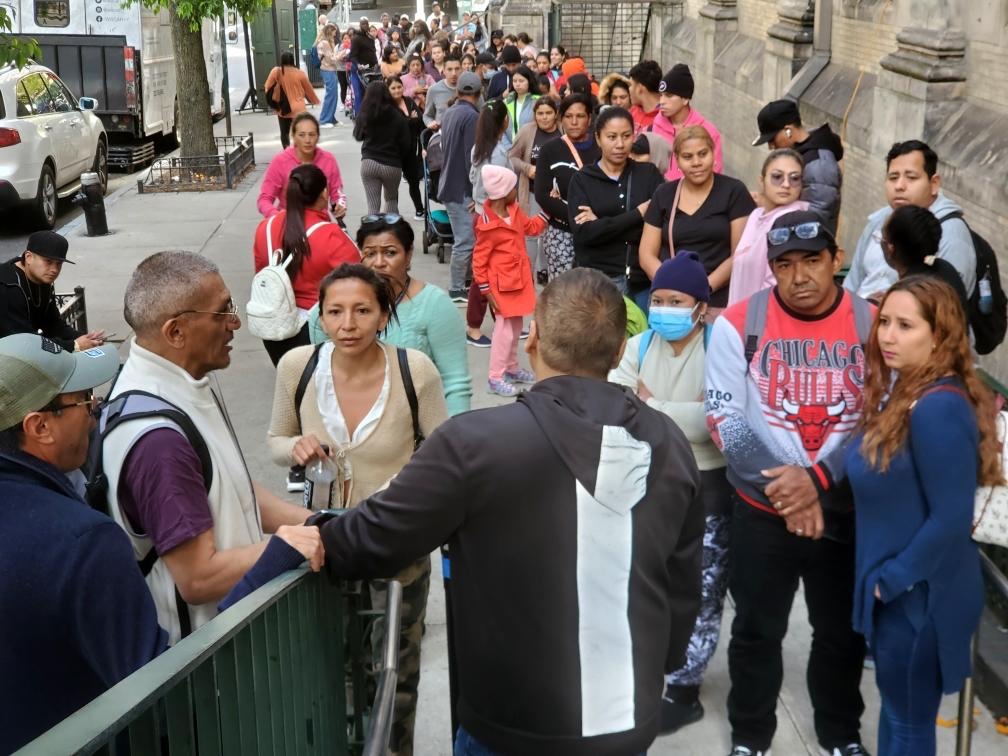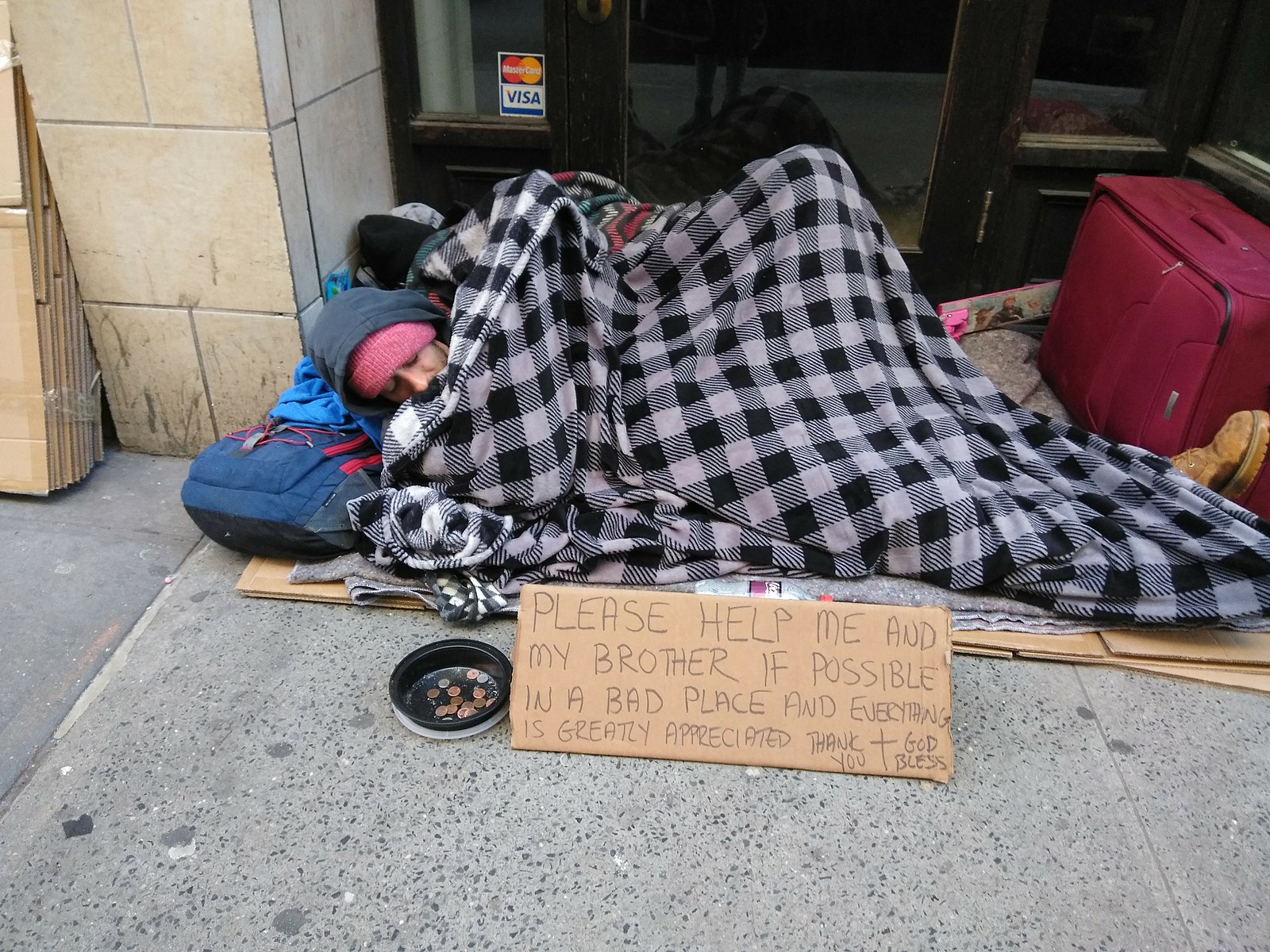
This article was originally published on May 23, 2023. We are reposting it because the “right to shelter” is at the center of the current migrant crisis facing New York City and the neighborhood — and because its sustainability, as it stands, is being questioned. The same week this story first appeared, Mayor Eric Adams asked a judge to limit the right to shelter to only homeless families with children. Prior to that, by executive order, he altered the rules about what the city must provide homeless people. This story explains the origin, provisions, and evolution of the right to shelter, and where it might be headed.
By Alex Maroño Porto
New York is the only major city in the country that offers a legal “right to shelter” to anyone within its borders who requests it. There are no residency or income requirements. You can come from another city, state, country, or continent, and, if you have no place to stay, New York must shelter and feed you, in a timely manner, in a place that — theoretically — meets certain court-set standards.
The policy dates back several decades and typically has served those who are homeless for a host of economic, social, or psychological reasons. But now it’s in the news almost daily as the city grapples with an influx of tens of thousands of asylum seekers, many of whom arrive in need of immediate shelter. The asylum wave is fallout from the 2022 Russian invasion of Ukraine, the humanitarian emergency after the 2021 U.S. withdrawal from Afghanistan, and — the largest source of asylum seekers — the ongoing crises in Venezuela and other Latin American countries. U.S. Customs and Border Protection’s monthly statistics show the number of border crossers recorded by the agency remains close to record highs; in April, they totaled 211,401, 10% more than in March.
Republican governors such as Greg Abbott in Texas and Ron DeSantis in Florida have bused asylum seekers to cities led by Democratic politicians, in an effort to pressure the Biden administration to adopt more restrictive immigration laws. As the only major metropolitan area in the country with a “right to shelter,” New York City has sought a variety of solutions to find accommodation for many of the more than 50,000 who have arrived since April 2022, according to Mayor Eric Adams. But the numbers have strained an already overwhelmed shelter system, prompting the city government to call for a “reassessment” of the right to shelter — which in turn has prompted criticism from advocates for immigrants and the homeless.
What exactly is this right to shelter, and how has it been implemented at different moments of its history? The Rag takes a look.

The origins of the Right to Shelter
In the 1970s, street homelessness in New York and elsewhere became increasingly widespread as a result of the deinstitutionalization of mental health patients, a deep economic crisis, and staggering unemployment in the city that reached a high of 11.5% in March 1975. Robert Hayes, a journalist-turned-lawyer in the city, often talked with homeless men he encountered on the street. He raised their plight with city officials but “the city was still clawing its way back from its brush with bankruptcy,” Hayes told the Rag in a recent interview, “and I think it’s fair to say that nobody in the city government had any interest in expanding services for homeless people.”
So Hayes went to court, filing a lawsuit in which a homeless man, Robert Callahan, was the lead plaintiff claiming a right to shelter. Hayes hung the case on a phrase he found in the New York State Constitution, rewritten in 1937 during the depths of the Great Depression. “That period could be compared to the tsunami of poverty and homelessness we have in New York City today,” Hayes said in the Rag interview. In that rewrite, a provision was added to the constitution stating that “the aid, care and support of the needy are public concerns and shall be provided by the state.” The word “shall” was key, and the state Supreme Court sided with Hayes in deciding Callahan v. Carey, which made sheltering, or “short-term housing accompanied by support services,” a constitutional right in New York City.
Two years later, in 1981, New York City adopted the right to shelter for all homeless men, while women were included in 1983 and families with children in 1986.
“I think that the most important work that the litigation and the organizing of the 1980s did was to change the public view of homeless people and to humanize them,” Hayes told the Rag. “Maybe a little bit of that is necessary today again.”
How the Right to Shelter has evolved in New York City
Since the legal case was decided, each city administration has approached the right to shelter differently. After his reelection as mayor in 1981, Ed Koch laid the groundwork for a municipal shelter system, with barracks-like accommodations, and, by early 1983, the city operated 13 shelters, reported The New York Times. In order to break the cycle of homelessness, Koch also adopted a policy known as “Housing New York,” building more than 15,000 homes for this population as part of a 10-year plan.
“If a person ought to be in a shelter and has not been reached, that is a failure,” Koch said in 1985.
David Dinkins, Koch’s successor, expanded homeless policies by establishing the Department of Homeless Services in 1993 as a separate city agency. But that same year, a new election brought Rudy Giuliani to City Hall on a platform that explicitly criticized the city’s approach to the issue. At that point, city shelters housed about 24,000 people on a typical night. Giuliani said that number should be cut almost in half, and most shelter stays should be limited to no more than 90 days.
“New York City stands alone in the expansiveness of its homeless policies,” Giuliani’s campaign stated. “Were these policies effective, the city’s efforts could be applauded, but essentially they have proved to be useless and self-defeating.” Giuliani’s tenure was marked by stricter shelter rules, including requiring homeless people to work in order to be sheltered.
Mayor Michael Bloomberg’s term started with increasing levels of homelessness in the city; in January 2002, over 31,000 homeless children and adults slept in municipal shelters every night, according to the Coalition for the Homeless. The group said it was the largest one-year homelessness surge since the Great Depression. During Bloomberg’s tenure, he proposed several controversial measures, like placing homeless people in decommissioned luxury cruise ships bought in the Bahamas or in an unused Bronx jail (both of those ideas failed). He also proposed ending preferential treatment of homeless families in accessing federal housing vouchers, which was harshly criticized. The 2008 economic crisis only worsened homelessness, and in 2013, the last year of Bloomberg’s tenure, the number of homeless people sleeping at municipal shelters exceeded 50,000 for the first time, according to the Coalition’s estimates.
Enter Mayor Bill de Blasio in 2014. He tried to reverse course with two major plans outlined in slick marketing materials: Turning the Tide on Homelessness and Housing New York. The first one tried to transform the shelter strategy by, among other measures, keeping homeless people close to their neighborhoods and opening 20 new shelters every year over the following five years. The second one, a tribute to a much earlier policy of Mayor Koch, turned from shelters to focus on the lack of affordable housing. De Blasio’s ambitious plan aimed to build or preserve 200,000 units of affordable housing which, the mayor said, was achieved at the end of 2021. But according to the nonprofit Community Service Society, his plan didn’t provide adequate housing for the city’s very poorest residents.
Then the pandemic hit, making densely-populated shelters a potentially high-risk option for the homeless. De Blasio’s administration moved homeless people from crowded congregate shelters to private hotels, which had few or no customers because of COVID restrictions. Without community outreach and health supervision, however, tensions around converted hotels like The Lucerne on West 79th Street arose, with some neighbors complaining that residents abused drugs in public and engaged in violent behavior. But for some homeless people like Michael Alvarez, interviewed in 2020, sheltering at a hotel was an opportunity to rebuild their lives.
“I had my own room and because of that I got clean,” Alvarez told the Rag. “I wasn’t around drugs no longer.”

Sheltering in post-lockdown New York
After New York City started to reopen in mid-2021, many pandemic-era protections were eased. Homeless people were pulled out of hotels and moved back into city shelters, and a pandemic moratorium on evicting tenants expired on January 15, 2022, right after Mayor Eric Adams took office. That summer, more asylum seekers began arriving in the city, and homelessness skyrocketed; in December 2022, an average of 68,884 people slept in municipal shelters every night, according to the Coalition, straining resources. If all those people were put into one city, it would be New York state’s ninth most populous, ahead of Utica and Schenectady.
Drug abuse and mental health issues are two other contributors to homelessness. As Gothamist reported, drug overdoses represented close to half of the homeless deaths in the 2022 fiscal year, a 12% increase from the previous year. This overdose surge has been marked by an increase of drugs laced with fentanyl, a synthetic opioid 50 times stronger than heroin and lethal in quantities smaller than a pen tip. And the city’s mental health response has been labeled as “inadequate” by New York’s Public Advocate Jumaane D. Williams. In a 2022 report, Williams decried the city’s closure of four of eight respite care centers, which provide an alternative to hospitalization for people experiencing emotional crises.
But the biggest challenge for the city’s shelter system has been the recent influx of asylum seekers. In mid-May, approximately 700 asylum seekers were arriving in the city daily, reported Gothamist, and despite the city’s efforts to house them in hotels like the Belnord or former student housing like the Riverside Terrace Residence, the already overburdened shelter system was further strained.
“We need the assistance. We need an emergency action down at the border where we do a decompression strategy, so this does not fall on New York City,” Adams said last week in an interview with NY1.
News of the impending end to Title 42, a Trump-era immigration policy kept in place by President Biden until this month, also accelerated the number of migrants crossing the southern U.S. border. This measure allowed border officials to expel migrants under the premise of keeping “Americans safe and stop the spread of COVID-19,” but the end of the pandemic emergency terminated it. Fearing even more restrictive immigration policies would replace Title 42, asylum seekers tried to come to the country before it expired, prompting more than 10,000 daily encounters with federal officials in the days leading up to its end.
Can the Right to Shelter be improved?
Experts on housing and homelessness say that overcoming the current pressures on the city’s shelter system will require long-term solutions. The Doe Fund, a nonprofit established in 1985, emphasizes helping homeless clients find permanent paid jobs, which can enable them to pay for affordable housing. Having the means to pay for housing is key to alleviating homelessness, said Christopher Luggiero, The Doe Fund’s director of donor relations and communications. “We need to develop more permanent, affordable housing for low-income workers who are otherwise at risk of homelessness,” Luggiero said. “Shelters should be transitional housing. There needs to be investment in ways to get people not just into shelters, but out of them into their own housing.”
Key to finding the work that will enable them to pay for affordable housing are training and employment projects for the homeless, Luggiero said. “Work is an enormous safety valve for people who are entering the shelter system and experiencing homelessness.”
In the case of migrants, expedited work permits would allow them to make ends meet on their own, Adams has said. Governor Kathy Hochul joined him this week in urging the Biden Administration to speed up the work permit process; some project that allowing asylum seekers to work legally soon after arrival could liberate more than $1 billion dollars of public money every year.
“When you combine access to economic opportunity and work, with affordable housing and supportive housing, that reaches everyone where they are,” said Luggiero. “And if you just do one of these, it’s not going to solve the crisis.”
To receive WSR’s free email newsletter, click here.









https://world-habitat.org/news/our-blog/helsinki-is-still-leading-the-way-in-ending-homelessness-but-how-are-they-doing-it/
Helsinki provides this support to citizens, no? Not to any person who arrives from another country and who hasn’t paid into their system. There is a difference.
Population in Finland is more homogeneous. I’m sorry to say but they have a much higher standard of education, social norms and ethics.
Here, social norms and ethics are political pawns. Given our enormous diversity culturally, socioeconomically, etc. this model simply won’t work.
I wish it would though.
“The municipality of Helsinki owns 70% of the land in the city, including over 60,000 social housing units, and maintains a housing policy that increases this housing by around 6,000 units a year.”
I’d like to see an analysis of how Helsinki manages their public housing stock vs. how NYC does it. It’s probable that NYC would rank much lower on all factors because of governmental inefficiency, incompetence, and corruption.
While I don’t know the equivalent percentage of land owned by NYC, I’m sure parcels of land can be found outside of the prime locations where homeless people now live and congregate.
That is mind blowing! The same as public education, this would contribute to the long term health of the community that is New York City, and I’d be happy if that’s where my tax dollars went.
Finland is a social democracy but a homogeneous nation with a generally educated population , shared values and norms, and much less income/wealth inequality compared to the U.S.
It is unlikely that most Finns would be enthusiastic about a large number of low-income and low-education people crossing the border and receiving housing and services indefinitely…..
The people of Finland are footing that bill with some of the highest tax rates in the world. About 42% on average compared to about 24% here. No thanks
Higher taxes, yes, but also one of the most supportive societies in the world. Those taxes are spent on the quality of life of the community. We could stand to move in that direction.
It’s obvious the shelter policy needs to be reevaluated in light of the crisis. It must can’t be sustained.
If the right to shelter is based on the New York State Constitution, not just a city document, then it should apply to the entire state and Albany should be required to make other cities and localities take their fair share of the asylum seekers and pay for it as well. If it requires a new court case, then so be it, even if it means the city suing the state to force a consent decree for the entire state.
This is an important comment. A state-wide perspective seems to be what’s required. I imagine there’s at least as much space, housing, and work upstate as there is here. kudos.
Right to shelter is based on a consent decree. It wasn’t decided on the merits. No one wants to have this decided on its merits.
Correct. Activists (the ones who want to welcome everyone, but have us pay for them) fear that any litigation on right to shelter might wind up in the Supreme Court banning the concept completely. Hochul would fear political blowback if the litigation forced statewide right to shelter, more house seats in NY would flip from D to R, the consequences of which are terrifying, And Biden has a major vulnerability on immigration; he cannot be seen as doing anything that looks like he is supporting the migrants. End result? Our virtue signaling as a sanctuary city, could give us a Republican trifecta come next November.
To sum up your post:
“Dems created this crisis”
“God forbid Republicans are elected”
Ok.
“ more house seats in NY would flip from D to R, the consequences of which are terrifying, ”
That’s what’s terrifying to you? The fact that all these Ds created this absolutely insane migrant crisis and are not even trying to do anything about it is terrifying. This leadership is a complete failure and they have to be voted out.
Still clinging to the D is what got us into this in the first place. They know they are not likely to be voted out and do nothing for us, rather scoring political points and pandering to the loud radical left who hijacked the lead and stifled the moderates.
Time to vote all Ds out till they clean up their own party. I am a democrat but like many moderates am voting R this year.
All the Democrats I know are against open borders and against unchecked illegal immigration. It’s time for the Party to listen to its members and change their positions.
How can you blame the current politicians for this problem and then say that flipping from D to R would have terrifying consequences? Wouldn’t you want to replace poorly performing politicians with ones that would improve the situation? You can’t be half-pregnant.
This right to shelter has obvious humanitarian appeal; however, it also is fast becoming an unmanageable anachronism. It clearly invites descent upon this city (in a worsening fiscal crisis) at a time when the Federal government has not gotten migration under control; when other states feel over-burdened and reprehensibly perhaps but entirely understandably try to offload their surplus migrants into the “right to shelter”; and when worsening climactic and economic conditions make it entirely predictable that the deluge will only accelerate. The country can’t hope to solve all the problems of the poor and oppressed of the world, and the city certainly can’t do so alone. It is time to have some tough-minded and clear eyed policies to exclude excess migration that is not in the interest of this country, and time to put aside romantic but atavistic notions about the “nation of immigrants” and face the world as it is now, not as it was in 1890.
What is the purpose of legal immigration? Why does anyone even bother going through the legal process? Just show up? Is the issue really about the kinds of jobs they are filling? We care if it is a highly paid job but not if it is a low paid one? Are we fooling ourselves about the role DHS or ICE even play?
If this right applies to the entire state then the right wing towns and cites need to step up. One point needs to be made the needs to be some limitations such as residence, income, prioritizing families. Frankly it is both untenable and inappropriate that this right to shelter has pit needy New Yorkers at the end of the line.
I don’t know if Glen Cove is considered right wing but 1000 immigrant men were scheduled to be housed there this week. One of the residents commented that the men are unvetted and there’s no public transportation, so this doesn’t sound like an ideal situation either.
I mean they tell area workers who drive to take the train to work on the UWS. Try taking it from Glen Cove.
Or they could limit the right to shelter to US citizens and NYC residents. What happens when the cold and snow arrive? Or say 500,000 additional ‘migrants’ arrive? It’s not sustainable.
A few thoughts..
1. Right to Shelter in NYC should not be a way to circumvent the legal immigration system.
2. Right to Shelter in NYC should not be a lobbyist ploy to force the Federal Govt to make policy changes. Whether they are wiling to accept it or not, people are not pawns.
3. Back in the day, immigrants seeking a better life moved in with family members or friends, tripled up in tight quarters, until they were able to afford their own housing…or not. There was no expectation that their desire to immigrate was the responsibility of tax payers. People also lived in multi-generational households and those that didn’t or couldn’t work took care of the kids and elderly so that those who could work did. Again, it wasn’t the expectation that the government had to provide this support network to them so that they could secure work.
4. To this point, nobody is entitled to solo housing just because they don’t like what they have or are given.
5. The Social Services beast has become so large that there is no desire to make people self sufficient as this will result in less government funded jobs. So, this charade of a large underclass continues with no end in sight. There will NEVER be enough affordable housing since that will be the death of the social services machine. This is how incumbents get re-elected.
Aside from the current immigration situation, it should be noted that there is awareness of the right to shelter etc.
I’ve worked with families in the City’s homeless system and have been told (I did not ask) by parents (who came from other states) that they came to NYC and knew they’d get shelter/housing of some sort
Laws are not permanent (look at Roe v. Wade) and can be changed. The question is, can we afford to retain this law? What do the citizens of NY State want to do?
Even I, a dyed in the wool liberal who has worked with the homeless for over two decades, believes that it is time that Callahan be repealed. It was important and valuable for a while, but it has now become FAR more trouble than it is worth. We need to “stop the clock” and deal with the problem we have without worrying about it it getting even worse.
Yes, that was then, but this is now.
There never was/is a right to shelter. The city was sued by the Coalition Against Homelessness and rather than fighting it in court, to a very likely winning outcome, the city entered into a consent decree. Now the chickens have come home to roost. You get what and who you elected.
Perhaps you should think about that before you go vote in November and not just rubber stamp the party that has run this city into the ground.
Agreed. All candidates must present their positions and plans for this. And they need to present their financial plans that could support the numbers of migrants they are advocating for.
If the right to shelter is based on the NYS Constitution, why isn’t it state-wide?
The article doesn’t even mention that every time a woman has a baby out of wedlock she is entitled to an a apartment She cannot be forced to live with her parents or grandparentsThis tactic also reduces the number of apartments available to middle class workers.
The current NYC sanctuary system is costing the city 120k per family per year. ANew yorker would have to make 280k before taxes to have the equivalent amount spend on a migrant,
Who benefits? The hotel industry with100% occupancy Nobody cares and the city labor unions are in collusion with the mayor. The mayor has said that the migrants are creating well paying city union jobs to service the migrants. Nobody cares about middle class workers in private industry.
“Every time a woman has a baby out of wedlock” — to which women are you referring, Charles? Interesting analysis of who is benefitting, but labor union “collusion” — paranoia or fact?
The trouble with Socialism is that eventually you run out of other people’s money.”
Margaret Thatcher
How many New Yorkers bring home 10k per month? This is what NYC is spending per illegal immigrate, per month. This is insane.
I’m amazed that do-gooders have no issue with this.
Some of us who have much less money have plenty of objections, but we have no power to reassign possibly-misplaced spending priorities. Don’t tell us to vote R; that could be more detrimental generally.
Laws change and this one, created from the state constitution written in 1937, needs to change, NOW. It is a 50 year old law that is not accurate for our times. NYC and NY state, WAKE UP and fight. There is no time to lose. Vote for those that WILL get this law changed.
Because of nations, especially within the southern hemisphere, failing due to the damages brought by climate change, there will be tens, perhaps hundreds of millions of poor souls wandering the globe for betterment or survival. For those who advocate an “open city”, just how many millions of these wanderers are you prepared to welcome to New York? With how many families will you be prepared to share your home and income?
A NYC resident ( let’s say this is an elderly couple who have been paying taxes their whole life to the Federal gov’t, NY State and NYC) will not be able to get shelter soon due to thousands and thousands of illegal immigrants who skipped the line and are being housed.
Is this crazy?
Should every economically disadvantaged person in South America and Africa be able to be housed in NYC?
Is Mayor Adams plan to change the code for Midtown from commercial to housing really about affordable housing for NYC residents or is this going to be FREE HOUSING for migrants or illegal immigrants, whatever you are calling them.
THIS IS CRAZY.
IS NYC GOING TO BE A PLACE ONLY FOR THE BILLIONAIRES AND WELFARE RECIPIENTS?
Folks – speak up please.
Call Governor Hochul’s office – she is the person here who controls the situation.
Make your voice heard. It is nice to commiserate here, but help be the answer.
Governor’s phone –
1-518-474-8390 | Office hours: 9:00am to 5:00pm
Thank you Cathy for the call to action. This truly is in Gov. Hochul’s hands. Let the Governor know how you feel.
Most logical and humane solution would be to open up the right to shelter for all of New York State not New York City only.
Are you listening Governor Hochul?
So take a “local” problem and make it a problem for the entire state. That solves it!
The right to shelter should be rescinded, as well as our sanctuary city status. Why? Because we cannot afford it!! And we do not have unlimited space. 12 billion for illegal immigrants!!! (Stop with the term “migrants”–what will be the next new label–“foreign guests”. ) Spend more money on hiring 10,000 more cops , building more prisons and facilities to house mental patients and replace DA’s who don’t want to prosecute anyone.